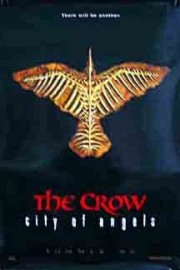The Crow: City of Angels
So much potential. So much opportunity. Wasted.
I’m not talking about the lives of the characters in “The Crow: City of Angels” but the film itself. As read in the novelization by Chet Williamson, the story by David S. Goyer (now a comic fan fave with his “Blade” trilogy and his “Batman” scripts with Chris Nolan) could’ve been the equal of Alex Proyas’ 1994 original. Maybe even better- a heresy to consider because of the dark poetry of Brandon Lee’s tragic final performance, and the original source of James O’Barr’s graphic novel- more tragic.
But studio politics prevailed, and now Tim Pope’s film stands as a pale imitator of Proyas’ instant Goth classic. Not as pale as the God-awful “The Crow: Wicked Prayer”- with a cast too good to be in a movie so terrible- but damn, multiple viewers are not kind to this film. The dark production design (by original “Crow” wizard Alex McDowell) looks more like miniatures and production design than a fully-realized city. The cinematography (by Jean Yves Escoffier) is of the shaky-cam, motion-sick variety that lacks the grace of Darius Wolzski’s work in the original film. And the performances. Well, let’s just say most of them border of camp- Vincent Perez (as The Crow character Ashe) is too over-the-top and too-little soulful; Mia Kirshner is too flat as the film’s spiritual center Sarah; and Richard Brooks is a little too philosophical as main heavy Judah Earl. Only the character of Curve (played by original O’Barr inspiration Iggy Pop) gets to the heart of the dark tragedy the story works to be; his arc when he’s given a tattoo of a Crow on his chest by Sarah is the most interesting in the film.
The setting of the story around the Mexican holiday of the Day of the Dead is ideal for this story of resurrection and revenge. It’s around this day when Ashe (Vincent Perez), a mechanic in Los Angeles, is brutally murdered along with his son Danny (Eric Acosta) by a gang of thugs headed by crime overlord Judah Earl (Richard Brooks, better known to geeks as Jubal Early from “Firefly”). The Crow resurrects him to set things right, one villain at a time. He finds a connection with Sarah (Mia Kirshner), the young girl from the original film, who’s had dreams of his rebirth, and a vision of a man with a woman in his arms, dead.
But their connection runs deeper than just having Sarah as a woman aware of what he’s going through, and that’s where “City of Angels” differs from the original film. The love story between Ashe and Sarah provides a tragic undercurrent between the two, as the living and dead begin to feel for one another, and the dark tragedy from the original film is mirrored in a unique way.
And it could’ve been even darker. As read in Williamson’s novel, the original idea was that- because of his connection with Sarah by the end- even after finishing his business with the living, Ashe would have been doomed to a purgatory of sorts, not being able to be reunited with either Danny or Sarah in the afterlife. But what the filmmakers and Miramax/Dimension give us in the end is more of the same, with good triumphing over evil, and Ashe finding peace. I guess the idea Goyer wanted to get at was a little too tragic for them in the end. I guarantee audiences would’ve loved it.
But even if the film drops the ball in the end, music still provides the beating heart of the film. The song soundtrack takes on a more grunge-punk flavor than the hard metal of the original film, with tracks from Rob Zombie, Hole, Iggy Pop, Bush, and Fuel that capture the tone of what Pope and co. were aiming for in the film. Still, the film’s MVP is Graeme Revell, who followed his masterful score for the original film with one here that goes one step further, not only enhancing the feeling of his dark love theme but also adding a Mexican flavor to the mix that distinguishes it from his work on the first film. One only need to listen to the cue “Lament for a Lost Son”- which brings all of these elements together in a mournful and evocative way that captures the dark sorrow of the original film and O’Barr’s original source- to get an idea of what could’ve been.
Instead, we get a film that plays more like an S&M enthusiasts twisted idea of a love story that revels in pain.










